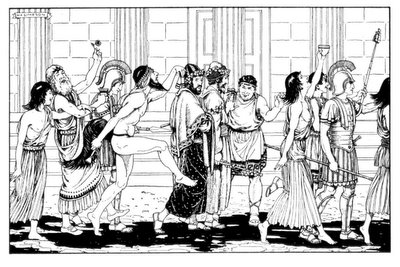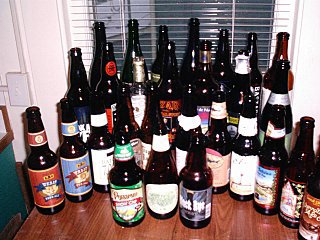I continue to sort through the archives in search of items that predate the Potable Curmudgeon’s blog, and to post those that aren’t too dated to provoke some measure of discussion.
Shortly after the following was written, the Bureau of Alcohol, Tobacco and Firearms took a renewed interest in the “malternative” phenomenon, a genre of alcoholic soft drinks that includes products like Smirnoff Ice and various “hard” lemonades, and began an overdue reconsideration of its regulations amid the anguished howling of a drinks industry intent on defending a cherished loophole to the last lobbyist.
All in all, growth of the category has slowed since the heady days of its inception around the turn of the century. Malternatives have not been given a separate category at the Great American Beer Festival. Now, as then, my business does not sell these bastardized cocktails for children, but admittedly, we continue to sell Woodchuck ciders … and sometimes I question the difference (or lack thereof), but that's a discussion for another day.-----
Charlie Papazian, founder of the American Homebrewers Association, was performing in Indianapolis the other day. I thought about going, if for no other reason than to ask him how he walks without a spine, and to imagine his response.
Charlie, Charlie, Charlie … like the rock star seeking to “reconnect” with his audience by playing “intimate” clubs (not coincidentally, the only venues that will him), he now stoops to reconquer the local markets that once nourished his career and that of the AHA by touring the country and appearing at brewpubs and homebrewing supply houses.
And so it came to pass that Charlie was only a two-hour drive away from New Albany, but there was a “Hogan’s Heroes” marathon on TV-Land. I decided to stay home.
Admittedly, my less-than-reverential attitude about a legitimate pioneer and icon of American homebrewing and beer appreciation will strike the wrong note for some readers.
So be it, but permit me one honest disclaimer: I sincerely respect Charlie Papazian for his homebrewing acumen and his essential how-to books. In truth, he has guided thousands of curious beer drinkers in their quest for good beer, and offered them a glimpse of the promised land where IPAs and Doppelbocks reign, and supermarket thirty-packs of aluminum-clad swill are distant, painful memories.
Unfortunately, that’s as far as Charlie’s magic goes, at least with me. The same qualities of laid-back temperament that make his message appealing in do-it-yourself circles, famously embodied by his “relax, don’t worry, have a homebrew” mantra, readily doom his opinions to irrelevance when applied to the real world that lies outside his garage brewery.
Some might say that my criticism of Charlie is unfair, that I expect too much from someone who at heart is a homebrewing evangelical, more at home in the backyard than the national stage.
Perhaps, but we mustn’t forget that the decision to venture into the world was made by Charlie himself. He created the whole Colorado-based beer and brewing empire currently grouped under the Association of Brewers umbrella, and has regarded it as a personal fiefdom. It has been good for him, and he good for it.
Regrettably, and delicately stated, there have been certain compromises along the way, and an accompanying erosion of moral authority on the part of a man who did so much for all of us in the beginning.
Our first hint of this soon-to-become-legendary Papazianesque dichotomy came in 1994, when it appeared that Anheuser-Busch would be permitted to swallow the Czech Republic’s Budvar brewery and thus “resolve” the longstanding copyright disagreements between the St. Louis-based liquid manufacturing plant and the classic Bohemian lager brewery that to this very day protects and enriches whatever conceptual meaning the word “Budweiser” still retains following a century of sustained abuse at the hands of the prime architect of the global swillocracy.
Asked by myself and the FOSSILS homebrewing club to join the crusade against Anheuser-Busch’s cynical maneuvering, Charlie ignominiously opted out – and just as quickly forbade the publication of his words to that effect.
Indeed, it was like Toto drawing back the curtain on the otherwise flaccid “wizard” when it became apparent that Charlie would do or say nothing to offend Anheuser-Busch or any of the other major industrial brewers, those benevolent despots who sponsor the annual Great American Beer Festival, but spend the rest of their business years conspiring to destroy everything the GABF stands for.
To be sure, the GABF as a tool of megabrewer appeasement wasn’t and isn’t anything new. One look at the many “made for the swill merchants” categories confirms this, which brings me to the most recent of Charlie’s missteps, as reported by David Pierce, who peruses various forums for brewers on line when he isn’t toiling to make Louisville safe for good beer.
The on-line debate in question concerned the Great American Beer Festival and whether “malternative” beverages would be accepted for judging and given their own category. It appears that they will not have a separate category, and will continue to be accepted in the existing “experimental beer” section, but it was an entertaining thread nonetheless.
For the uninitiated, such “malternatives” (or “alcopops,” as they’re referred to in the U.K.) include atrocities like Zima as well as the many newly emerging liquor-branded malt beverages (Smirnoff Ice, Skye, etc) being rushed into the marketplace by megabrewers eager to milk the latest hot trends in marketing to teenagers.
Wait – did I say that aloud? Marketing to teenagers? Why, don’t all of the industrial brewers routinely deny such these charges and invest millions of dollars in programs to discourage and deter underage drinking?
Yes, they do, and they also invest millions of dollars for the development of alcoholic beverages that taste like soda pop, not beer … and we are assured that these malternative beverages are being marketed to adults, not children … and the way you can be sure that a megabrewer is lying when he tells you all this is that his lips are moving.
The point is this: The profit-at-any-human-cost motives of the industrial swill merchants are so shabbily and obviously transparent that it seems almost assured that their “malternative” beverages will be the next great lightning rod that brings the legislative wrath of the health fascists, mad mothers and do-gooders crashing down on all our heads, not just those of the biggest companies who have the lawyers and the money to fight a rear-guard action until their research and development team creates the next “use” for beer.
And wandering airily among the wreckage will be Charlie Papazian, one organizational hand in the pockets of Megaswill, Inc., and another making soothing gestures designed to convince us to relax, don’t worry, and have another dose of punishment brought about by the monoliths to whom he remains beholden.
For the record – and if Charlie doesn’t mind being quoted – here are a few of his comments with respect to the GABF and “malternative” beverages:
" … if the GABF were to decide what is an alcopop and what isn't; what kinds of fermented malt beverages do we allow and which ones do we disallow - then who would dare risk the liability and potential of being perceived as restricting trade. Lawyers drool at these kinds of opportunities … "
" … Like it or not, for now malt based alcoholic fruit flavored beverages are part of the beer market … "
" … remember OTHERS despised, snickered, laughed, criticized what we call the innovations of the early craft brewers. They said it wasn't good for the image of beer. It's not what they wanted beer to become … "
" … our present policies keep the GABF open to the extraordinary creativity of all brewers. I think we all agree that brewers will never totally agree on these kinds of issues. But the GABF shouldn't be policing the industry. The suggested policing is not enforceable, has legal implications and would entail great expense ... "
Simply stated, Charlie’s shuck and jive never changes. Following the e-mail posting from which I’ve quoted, his sycophants rushed to support the freshly enunciated writ, thus further cheapening the GABF while bringing smiles to the suits in the corporate boardrooms of the industrial brewers:
“It would be a shame to see the very diversity that has fueled this industry for the last many years diminish based on an arbitrary opinion of whether a given product segment is legitimate or not. The market has been and will continue to be the ultimate judge for all products made by brewers in this country.”-- Chris Swersey, PPBT Manager - GABF and World Beer Cup
Alice, welcome to Wonderland. Alcopops are the same as lambics, ethical standards are lawsuits waiting to happen, the cow jumped over the moon, and in their rush to appease the swill merchants, Charlie and Chris both seem to forget that if their newfound passivity and trust in the veracity of “the market” had been the rule in the early days of the homebrewing movement and the microbrewing revolution, neither would have occurred.
In 1992, the market here in New Albany rather emphatically has said, “swill!”
Should I have trusted the “market”? Was it a waste of time for me to ignore the “market,” to install extra draft lines, to sell the best beer possible at a fair price while striving always to educate and reshape the “market”?
Should I have been afraid of offending the Bud, Miller and Coors distributors whose sales indicated a good understanding of the “market’s” requirements?
Of course not.
Here’s an interesting hypothetical proposition: If Anheuser-Busch were to approach Charlie and Chris, checkbook in hand, with the offer to fully finance the Great American Beer Festival, put an end to shortfalls, purchase whatever the festival needs to survive and prosper … only one small thing, it must now be called the Anheuser-Busch Great American Beer Festival … how long would it take for the offer to be refused?
Or would it be refused? After all, to refuse Anheuser-Busch is to jilt 50% of the “market.”
By coincidence, I recently picked up an old issue of “zymurgy” in which Charlie ruminated about how far the homebrewing and beer appreciation movement had come since those early days high in Colorado. He fondly recalled his solemn induction into a Belgian beer society, which previously had accepted only one other American: August Busch III, known ‘round these parts as Three Sticks, whose financial support of the Great American Beer Festival in Denver makes about as much sense as Saddam Hussein hosting a human rights conference in Basra.
The differences between Charlie and I couldn’t be illuminated any more clearly than by my noting that if Three Sticks ever were to pass through the portals of Rich O’s, I would unhesitatingly spit in his general direction … and that’s the printable part of my reaction. Paraphrasing Groucho Marx: I wouldn’t want to join any club that would have Three Sticks as a member.
Charlie, are you there?
It’s time for you to stand up and be counted. You can no longer shirk the responsibility of the position that you created for yourself. Leaders lead, or they get out of the way … and as for the policy of appeasement, we all remember Neville Chamberlain’s place in history, don’t we?
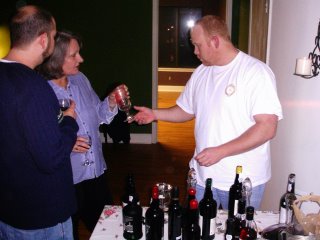 The basics of Port are familiar to many readers: Fortified wine from Portugal, mostly red and always sweet, and a great libation after dinner, with cheese, or accompanied by a good cigar.
The basics of Port are familiar to many readers: Fortified wine from Portugal, mostly red and always sweet, and a great libation after dinner, with cheese, or accompanied by a good cigar.
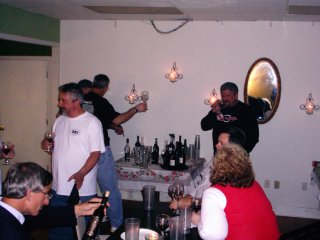 There have been sporadic efforts in the past to gather together local Port lovers for such an event during the holiday season. Last evening's was a BYOB affair, with those in attendance also bringing small nibbles.
There have been sporadic efforts in the past to gather together local Port lovers for such an event during the holiday season. Last evening's was a BYOB affair, with those in attendance also bringing small nibbles.


 The keg we had was at least a year and a half old, and the transformation through aging of what is always a fine, strong Belgian was a source of wonderment. The rich and almost mead-like foundation was complemented by a gentle and appropriate oxidization, lending the familiar sherry notes and a pronounced nuttiness to the palate.
The keg we had was at least a year and a half old, and the transformation through aging of what is always a fine, strong Belgian was a source of wonderment. The rich and almost mead-like foundation was complemented by a gentle and appropriate oxidization, lending the familiar sherry notes and a pronounced nuttiness to the palate. BBC pub brewmaster Jerry Gnagy’s Mephistopheles and Bourbon Barrel Smoked Porter were fine accompaniments to the spicy poultry, and took the edge right off the stressful (?) morning.
BBC pub brewmaster Jerry Gnagy’s Mephistopheles and Bourbon Barrel Smoked Porter were fine accompaniments to the spicy poultry, and took the edge right off the stressful (?) morning.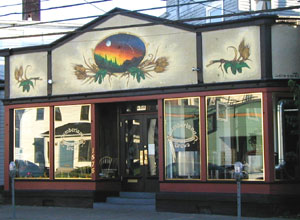
 You’ve already read shameless plugs for Maido in these pages, and please endure another reminder that if you’ve not visited yet, make it a point to plan an expedition very soon.
You’ve already read shameless plugs for Maido in these pages, and please endure another reminder that if you’ve not visited yet, make it a point to plan an expedition very soon.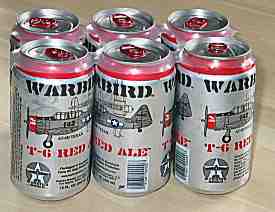


 It tastes good sampled out of the fermenter, but it’s a bit young.
It tastes good sampled out of the fermenter, but it’s a bit young. Many early brewers worked their trade as a sideline or temporary trade before moving on to other occupations. Hew Ainslie is unique for having been principally a poet.
Many early brewers worked their trade as a sideline or temporary trade before moving on to other occupations. Hew Ainslie is unique for having been principally a poet. 